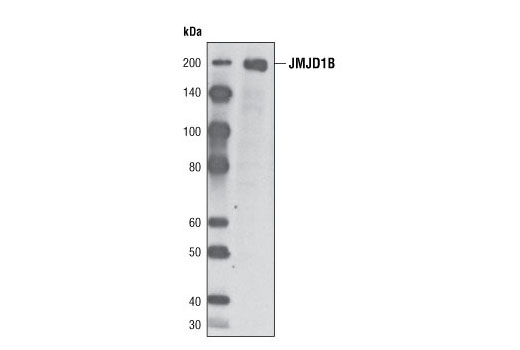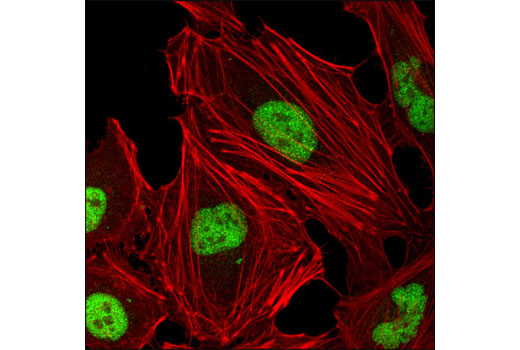WB, IP, IF-IC
H M R Mk
Endogenous
220
Mouse IgG1
#Q7LBC6
51780
Product Information
Product Usage Information
| Application | Dilution |
|---|---|
| Western Blotting | 1:1000 |
| Immunoprecipitation | 1:50 |
| Immunofluorescence (Immunocytochemistry) | 1:200 |
Storage
Specificity / Sensitivity
Species Reactivity:
Human, Mouse, Rat, Monkey
Source / Purification
Monoclonal antibody is produced by immunizing animals with a recombinant protein corresponding to the sequence of human JMJD1B.
Background
The methylation state of lysine residues in histone proteins is a major determinant of the formation of active and inactive regions of the genome and is crucial for the proper programming of the genome during development (1,2). Jumonji C (JmjC) domain-containing proteins represent the largest class of potential histone demethylase proteins (3). The JmjC domain of several proteins has been shown to catalyze the demethylation of mono-, di-, and tri-methyl lysine residues via an oxidative reaction that requires iron and α-ketoglutarate (3). Based on homology, both humans and mice contain at least 30 such proteins, which can be divided into seven separate families (3). The JMJD1 (Jumonji domain-containing protein 1) family, also known as JHDM2 (JmjC domain-containing histone demethylation protein 2) family, contains four members: hairless (HR), JMJD1A/JHDM2A, JMJD1B/JHDM2B, and JMJD1C/JHDM2C. Hairless is expressed in the skin and brain and acts as a co-repressor of the thyroid hormone receptor (4-6). Mutations in the hairless gene cause alopecia in both mice and humans (4,5). JMJD1A is expressed in meiotic and post-meiotic male germ cells, contributes to androgen receptor-mediated gene regulation, and is required for spermatogenesis (7-9). It has also been identified as a downstream target of OCT4 and STAT3 and is critical for the regulation of self-renewal in embryonic stem cells (10,11). JMJD1B is a more widely expressed family member and is frequently deleted in myeloid leukemia (12). JMJD1C (also known as TRIP8) is a co-factor of both the androgen and thyroid receptors and has a potential link to autism (13-15). Members of the JMJD1/JHDM2 family have been shown to demethylate mono-methyl and di-methyl histone H3 (Lys9) (3,8).
- Kubicek, S. et al. (2006) Ernst Schering Res Found Workshop , 1-27.
- Lin, W. and Dent, S.Y. (2006) Curr Opin Genet Dev 16, 137-42.
- Klose, R.J. et al. (2006) Nat Rev Genet 7, 715-27.
- Cachon-Gonzalez, M.B. et al. (1994) Proc Natl Acad Sci USA 91, 7717-21.
- Ahmad, W. et al. (1998) Science 279, 720-4.
- Potter, G.B. et al. (2001) Genes Dev 15, 2687-701.
- Höög, C. et al. (1991) Mol Reprod Dev 30, 173-81.
- Yamane, K. et al. (2006) Cell 125, 483-95.
- Okada, Y. et al. (2007) Nature 450, 119-23.
- Loh, Y.H. et al. (2007) Genes Dev 21, 2545-57.
- Ko, S.Y. et al. (2006) Cell Struct Funct 31, 53-62.
- Hu, Z. et al. (2001) Oncogene 20, 6946-54.
- Lee, J.W. et al. (1995) Mol Endocrinol 9, 243-54.
- Wolf, S.S. et al. (2007) Arch Biochem Biophys 460, 56-66.
- Castermans, D. et al. (2007) Eur J Hum Genet 15, 422-31.
Species Reactivity
Species reactivity is determined by testing in at least one approved application (e.g., western blot).
Western Blot Buffer
IMPORTANT: For western blots, incubate membrane with diluted primary antibody in 5% w/v nonfat dry milk, 1X TBS, 0.1% Tween® 20 at 4°C with gentle shaking, overnight.
Applications Key
WB: Western Blotting IP: Immunoprecipitation IF-IC: Immunofluorescence (Immunocytochemistry)
Cross-Reactivity Key
H: human M: mouse R: rat Hm: hamster Mk: monkey Vir: virus Mi: mink C: chicken Dm: D. melanogaster X: Xenopus Z: zebrafish B: bovine Dg: dog Pg: pig Sc: S. cerevisiae Ce: C. elegans Hr: horse GP: Guinea Pig Rab: rabbit All: all species expected
Trademarks and Patents
使用に関する制限
法的な権限を与えられたCSTの担当者が署名した書面によって別途明示的に合意された場合を除き、 CST、その関連会社または代理店が提供する製品には以下の条件が適用されます。お客様が定める条件でここに定められた条件に含まれるものを超えるもの、 または、ここに定められた条件と異なるものは、法的な権限を与えられたCSTの担当者が別途書面にて受諾した場合を除き、拒絶され、 いかなる効力も効果も有しません。
研究専用 (For Research Use Only) またはこれに類似する表示がされた製品は、 いかなる目的についても FDA または外国もしくは国内のその他の規制機関により承認、認可または許可を受けていません。 お客様は製品を診断もしくは治療目的で使用してはならず、また、製品に表示された内容に違反する方法で使用してはなりません。 CST が販売または使用許諾する製品は、エンドユーザーであるお客様に対し、使途を研究および開発のみに限定して提供されるものです。 診断、予防もしくは治療目的で製品を使用することまたは製品を再販売 (単独であるか他の製品等の一部であるかを問いません) もしくはその他の商業的利用の目的で購入することについては、CST から別途許諾を得る必要があります。 お客様は以下の事項を遵守しなければなりません。(a) CST の製品 (単独であるか他の資材と一緒であるかを問いません) を販売、使用許諾、貸与、寄付もしくはその他の態様で第三者に譲渡したり使用させたりしてはなりません。また、商用の製品を製造するために CST の製品を使用してはなりません。(b) 複製、改変、リバースエンジニアリング、逆コンパイル、 分解または他の方法により製品の構造または技術を解明しようとしてはなりません。また、 CST の製品またはサービスと競合する製品またはサービスを開発する目的で CST の製品を使用してはなりません。(c) CST の製品の商標、商号、ロゴ、特許または著作権に関する通知または表示を除去したり改変したりしてはなりません。(d) CST の製品をCST 製品販売条件(CST’s Product Terms of Sale) および該当する書面のみに従って使用しなければなりません。(e) CST の製品に関連してお客様が使用する第三者の製品またはサービスに関する使用許諾条件、 サービス提供条件またはこれに類する合意事項を遵守しなければなりません。


